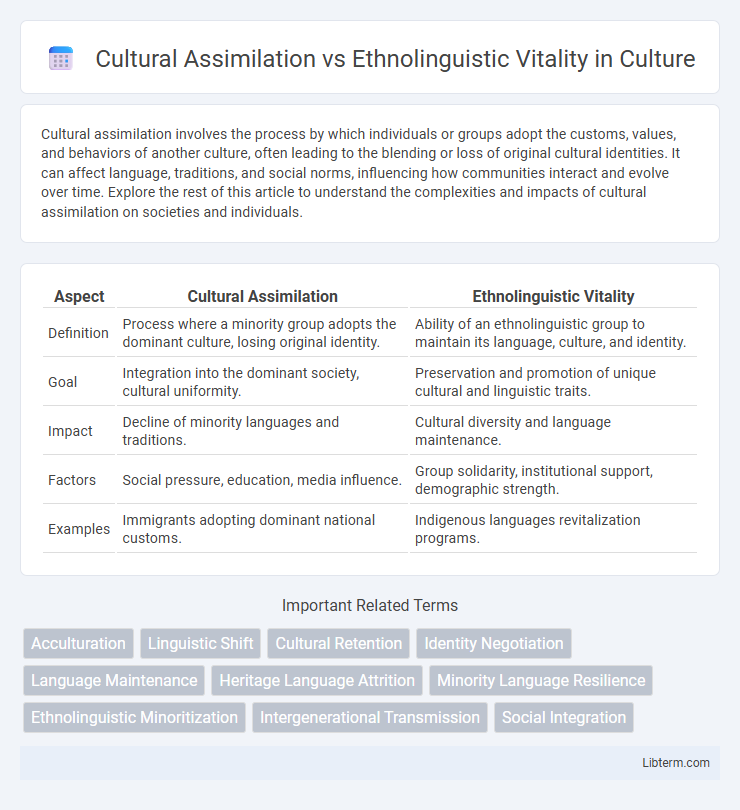Cultural assimilation involves the process by which individuals or groups adopt the customs, values, and behaviors of another culture, often leading to the blending or loss of original cultural identities. It can affect language, traditions, and social norms, influencing how communities interact and evolve over time. Explore the rest of this article to understand the complexities and impacts of cultural assimilation on societies and individuals.
Table of Comparison
| Aspect | Cultural Assimilation | Ethnolinguistic Vitality |
|---|---|---|
| Definition | Process where a minority group adopts the dominant culture, losing original identity. | Ability of an ethnolinguistic group to maintain its language, culture, and identity. |
| Goal | Integration into the dominant society, cultural uniformity. | Preservation and promotion of unique cultural and linguistic traits. |
| Impact | Decline of minority languages and traditions. | Cultural diversity and language maintenance. |
| Factors | Social pressure, education, media influence. | Group solidarity, institutional support, demographic strength. |
| Examples | Immigrants adopting dominant national customs. | Indigenous languages revitalization programs. |
Introduction to Cultural Assimilation and Ethnolinguistic Vitality
Cultural assimilation refers to the process in which individuals or groups adopt the cultural traits of another group, often leading to the reduction of their original cultural identity. Ethnolinguistic vitality measures the likelihood of a language or ethnic group's survival, influenced by factors such as status, demographic strength, and institutional support. Understanding the dynamics between cultural assimilation and ethnolinguistic vitality is crucial for analyzing language maintenance and shifts within multicultural societies.
Defining Cultural Assimilation: Key Concepts
Cultural assimilation refers to the process by which individuals or groups adopt the cultural traits, values, and behaviors of another dominant group, leading to the reduction of ethnic distinctions. Key concepts include acculturation, which involves adapting to a new cultural environment, and social integration, signifying participation in mainstream social institutions. This process often results in diminished ethnolinguistic vitality, the strength and visibility of a language or ethnic group within a community.
Understanding Ethnolinguistic Vitality: Core Elements
Ethnolinguistic vitality refers to the degree to which a language group maintains its cultural distinctiveness and social influence within a larger society, influenced by factors such as status, demographic strength, and institutional support. Core elements include the group's population size and distribution, social prestige associated with the language, and the presence of institutions like schools and media that promote language use. These components determine the group's ability to resist cultural assimilation and sustain its language and identity over time.
Historical Perspectives on Cultural Integration
Historical perspectives on cultural integration reveal contrasting outcomes between cultural assimilation and ethnolinguistic vitality, with assimilation often involving the loss of distinct cultural identities through enforced language and social norms. Ethnolinguistic vitality emphasizes the preservation and active promotion of minority languages and cultural practices as essential for maintaining group identity and resistance to cultural homogenization. Studies of immigrant communities demonstrate how policies favoring assimilation historically marginalized minority cultures, whereas supportive frameworks for ethnolinguistic vitality contribute to sustained cultural diversity and social cohesion.
Factors Influencing Cultural Assimilation
Factors influencing cultural assimilation include language proficiency, social integration, and intergroup contact frequency, which significantly impact an individual's ability to adapt to a dominant culture. Economic opportunities and educational access also play critical roles in shaping assimilation processes by facilitating or hindering participation in mainstream society. Furthermore, policies promoting multiculturalism or assimilation, along with community attitudes, affect the willingness and extent to which ethnolinguistic groups assimilate culturally.
Determinants of Ethnolinguistic Vitality
Determinants of ethnolinguistic vitality include factors such as the group's demographic strength, institutional support, and status within the larger society. Language transmission within families, access to education in the mother tongue, and positive media representation enhance a group's vitality. Strong cultural practices and social networks also reinforce group identity, counteracting pressures toward cultural assimilation.
Social Identity and Language Preservation
Cultural assimilation often leads to the erosion of ethnolinguistic vitality by diminishing the social identity tied to native languages and traditions. Maintaining strong social identity through community-driven language preservation efforts supports ethnolinguistic vitality and counters the homogenizing effects of dominant cultural forces. Language preservation initiatives, including education in mother tongues and cultural events, reinforce social identity and promote resilience against cultural assimilation.
Consequences of High Assimilation vs Sustained Vitality
High cultural assimilation often results in diminished ethnolinguistic vitality, leading to the erosion of minority languages and traditions, weakening group identity and social cohesion. Sustained ethnolinguistic vitality promotes the preservation of language, customs, and collective self-esteem, enhancing cultural diversity and intergenerational transmission of heritage. Consequences of high assimilation include cultural homogenization and potential loss of unique worldviews, while maintained vitality supports community resilience and multicultural societal enrichment.
Case Studies: Communities Navigating Assimilation and Vitality
Case studies reveal that communities balancing cultural assimilation and ethnolinguistic vitality often employ bilingual education and cultural festivals to sustain heritage languages while adapting to dominant cultures. Research on Indigenous groups in Canada illustrates how maintaining traditional language use correlates with stronger community identity amidst external pressures to assimilate. Similarly, urban immigrant populations in the United States showcase mixed-language environments where language retention strategies support ethnolinguistic vitality, counteracting language shift and loss.
Policies and Strategies Supporting Ethnolinguistic Vitality
Policies supporting ethnolinguistic vitality emphasize the promotion and protection of minority languages through education, media, and legal recognition, fostering positive group identity and intergenerational language transmission. Strategies include implementing bilingual education programs, granting official status to minority languages, and funding cultural initiatives that reinforce language use in public and private spheres. These approaches counteract cultural assimilation by empowering ethnolinguistic communities to maintain their distinct linguistic and cultural heritage within a pluralistic society.
Cultural Assimilation Infographic

 libterm.com
libterm.com